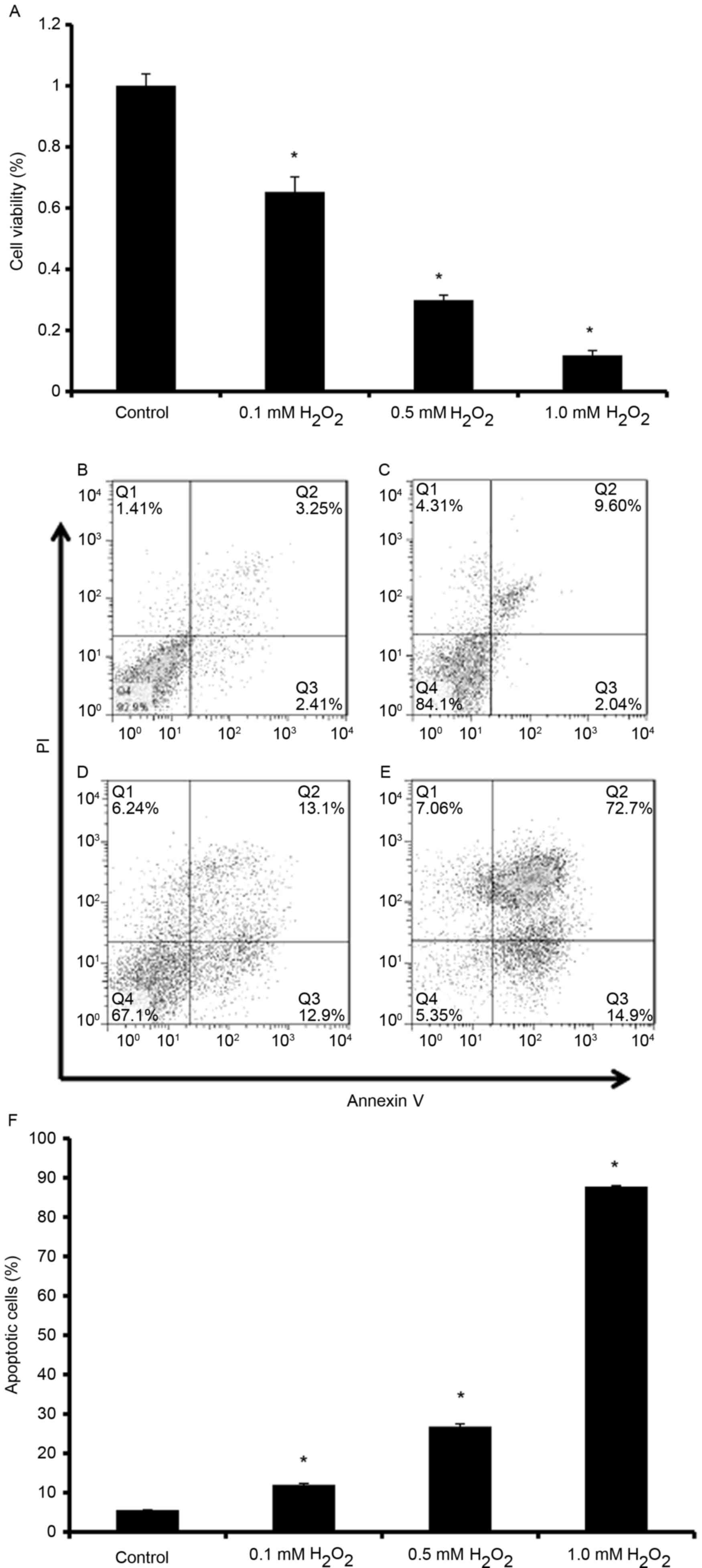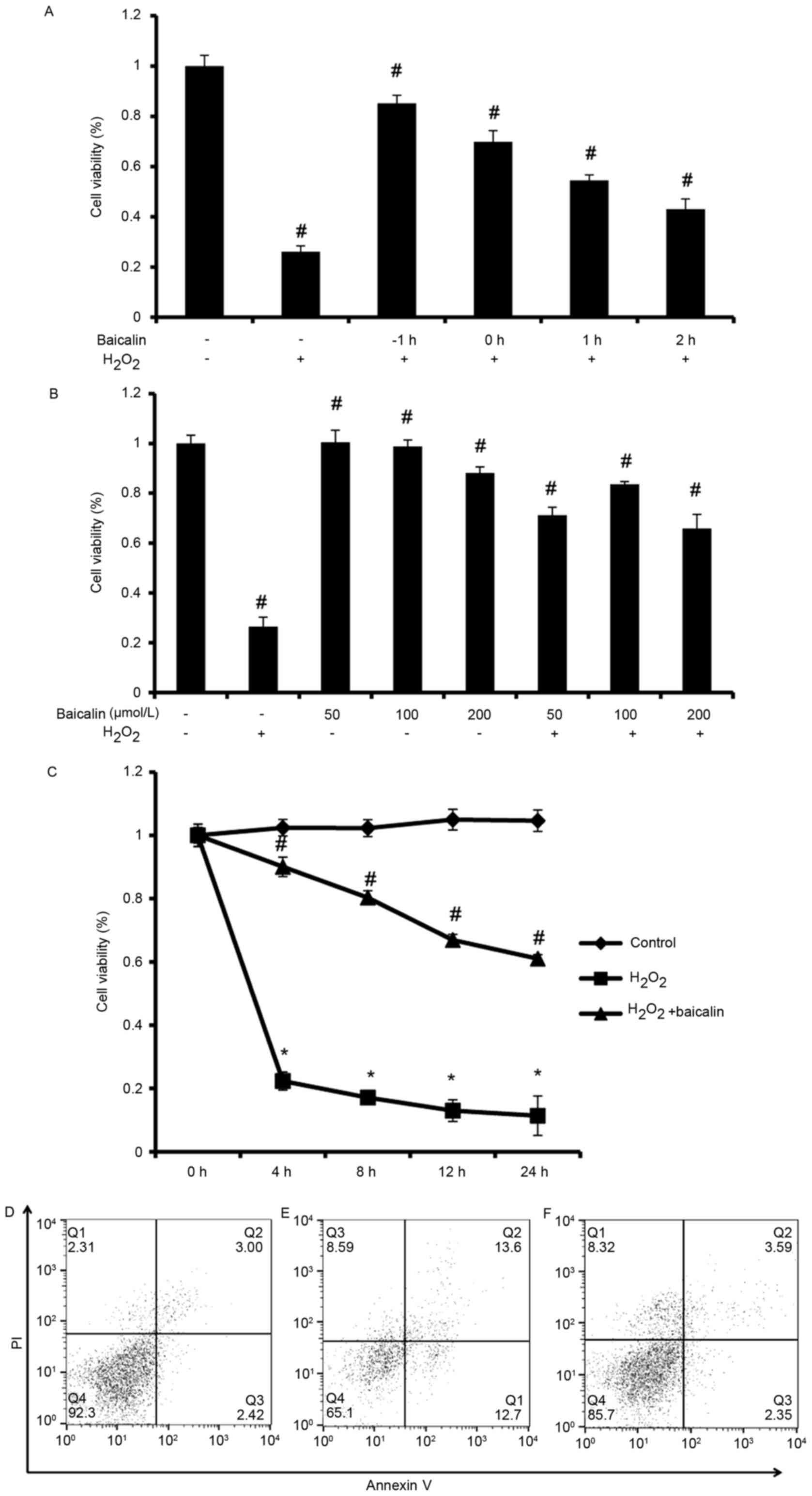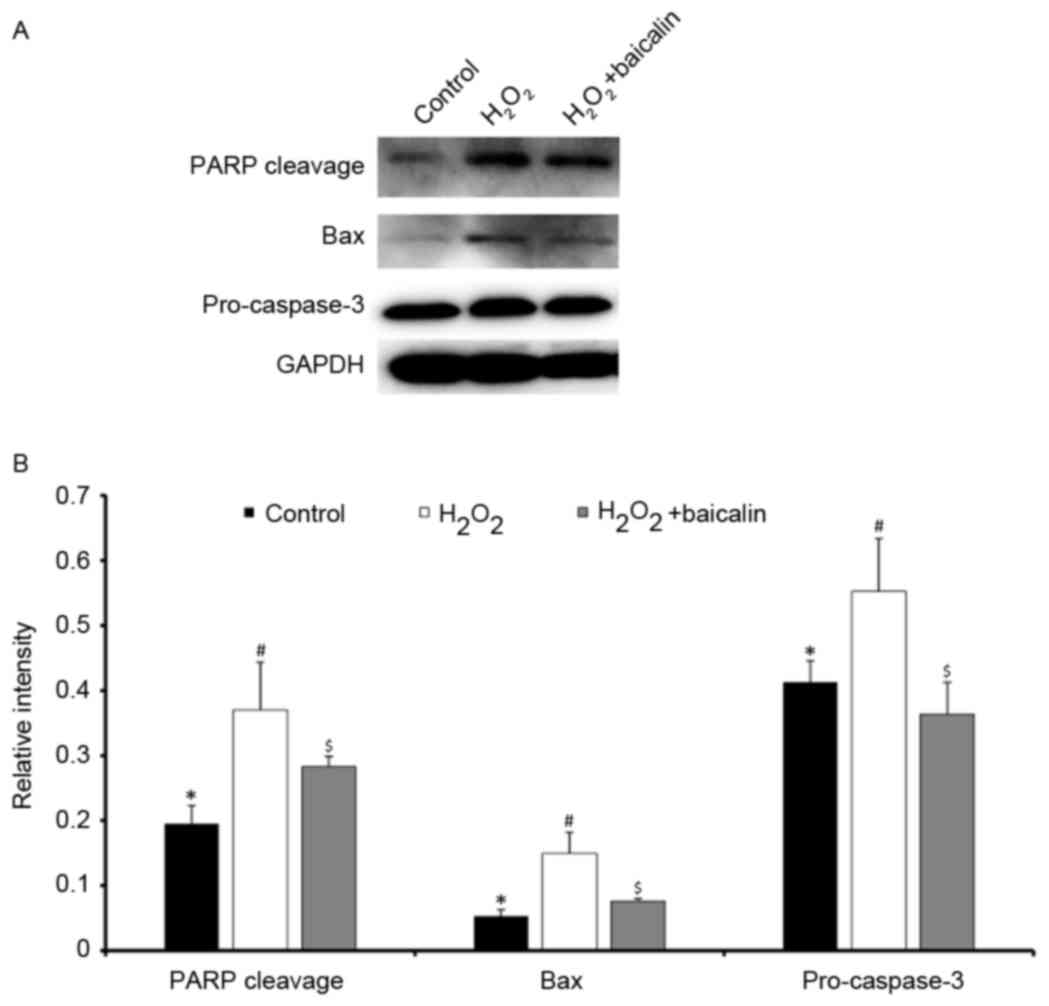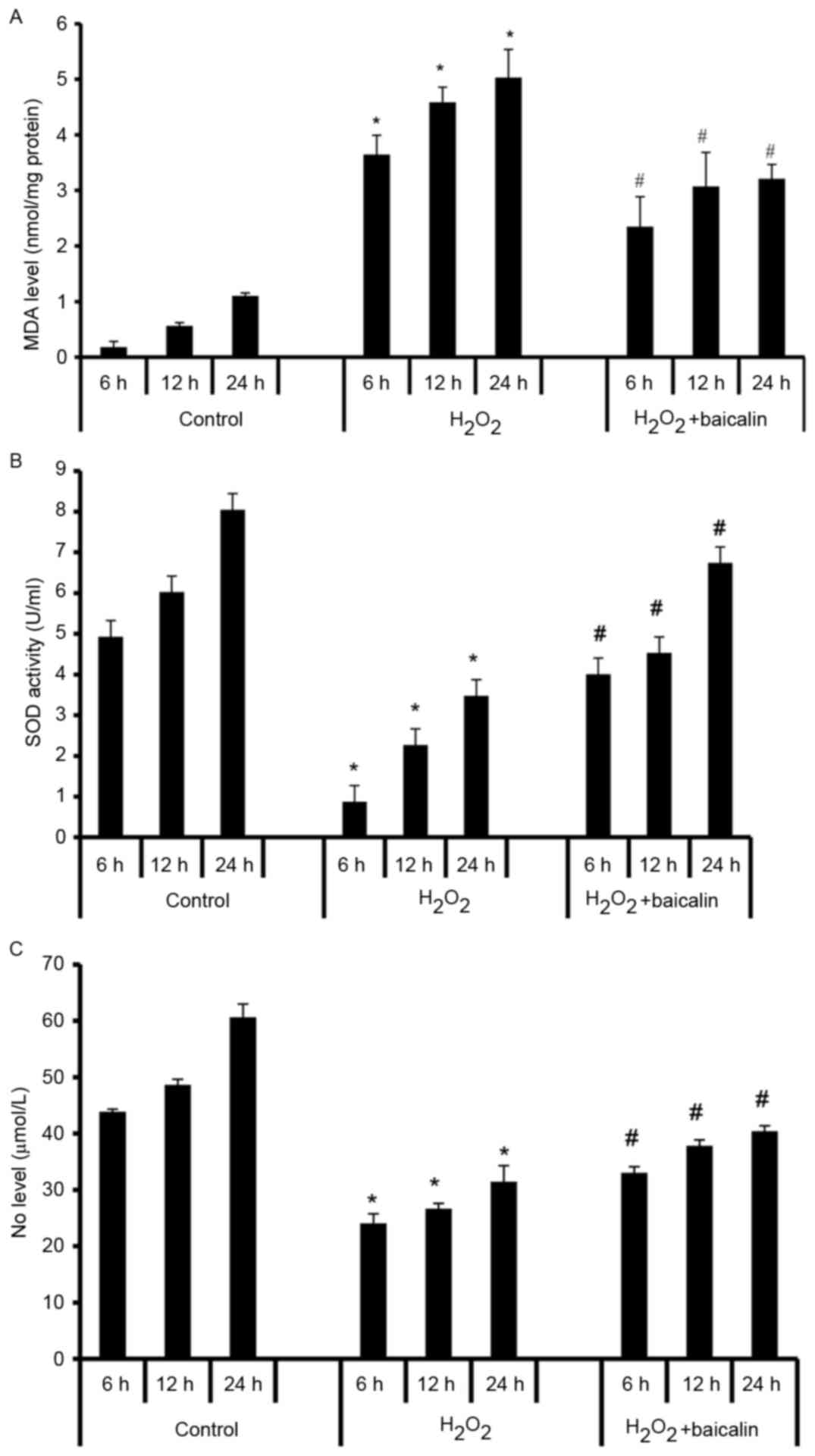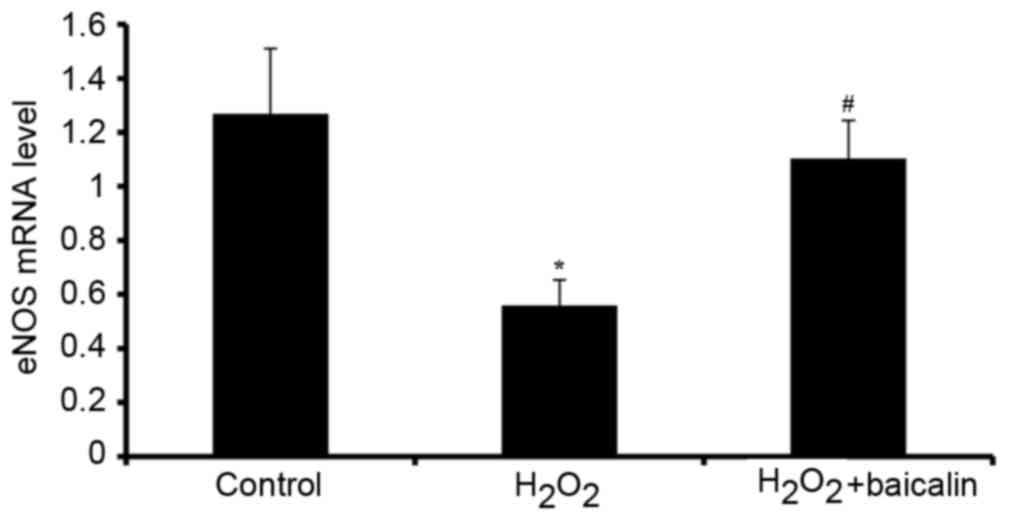Baicalin prevents the apoptosis of endplate chondrocytes by inhibiting the oxidative stress induced by H2O2
- Authors:
- Published online on: June 30, 2017 https://doi.org/10.3892/mmr.2017.6904
- Pages: 2985-2991
Abstract
Introduction
Osteoarthritis (OA) is a degenerative disease of articular cartilage, which is characterized by local and progressive destruction of articular cartilage, and osteophyte formation in the subcartilage edges, and is often accompanied by synovial inflammation. At present, the pathogenesis of articular cartilage injury in OA remains to be fully elucidated. Studies in previous decades have confirmed that oxidative stress is important in the pathogenesis and progression of OA (1,2). Oxidative stress is characterized by excessive reactive oxygen species (ROS) production and reduced cellular antioxidant activity, leading to membrane lipid peroxidation and mitochondrial dysfunction (3–5). If oxidative insult persists, programmed cell death is initiated, which can cause apoptosis of chondrocytes and extracellular matrix degradation (1,2).
Oxidative stress is primarily caused by the excessive accumulation of ROS, which include hydrogen peroxide (H2O2), superoxide anions and hydroxyl radicals. H2O2 is a major component of ROS and is used extensively as an inducer in oxidative stress models (5–9). Therefore, treatment strategies with the potential to prevent oxidative stress induced by H2O2 are considered valuable for patients with OA. Baicalin is a flavonoid glycoside extracted from a type of traditional Chinese medicine, Scutellaria baicalensis, and its chemical structure has been determined (10). Baicalin has been shown to possess antibacterial, anti-inflammatory and anti-apoptotic properties, and is widely used in the treatment of infectious and inflammatory diseases (8,11–14).
The aim of the present study was to investigate the potential protective effects of baicalin treatment on H2O2-induced oxidative stress in endplate chondrocytes in vitro, particularly its effect on cell apoptosis.
Materials and methods
Isolation and culture of primary rat endplate chondrocytes
A total of 40 4-week-old male Sprague-Dawley rats weighing 160–200 g were obtained from Shanghai SLAC Laboratory Animal Co., Ltd. (Shanghai, China) and housed at a temperature of 26°C, 40–60% humidity, standard diet and a 14-h light/10-h dark cycle. Rat endplate chondrocytes were obtained following cervical dislocation after anesthesia according to a previous study (15,16). In brief, the region of the lumbar posterior midline was shaved and then covered with sterile drapes. The rats were placed in a prone position on the operating table. Cartilage of the L3-L5 endplates was carefully removed from the vertebrae and placed into a small beaker with high-glucose (4.5 g/l; 25 mM) Dulbecco's modified Eagle's medium (DMEM; Gibco; Thermo Fisher Scientific, Inc., Waltham, MA, USA). Sterile ophthalmic scissors were used to cut the tissues into 1-mm3 sections, and these were transferred to a 50-ml sterile test tube. The tissues were digested with 0.25% trypsin (Hyclone; GE Healthcare Life Sciences; Logan, UT, USA) at 37°C for 30 min, followed by the addition of 0.2% collagenase (Sigma; Merck KGaA; Darmstadt, Germany) at 37°C for 2 h. Following centrifugation (400 × g for 10 min at room temperature), the supernatant was discarded and the tissue suspension was washed three times with DMEM with 10% heat-inactivated fetal bovine serum (FBS; Gibco; Thermo Fisher Scientific, Inc.). The released cells were cultured in DMEM with 10% FBS, 100 U/ml penicillin and 100 µg/ml streptomycin (both from Gibco; Thermo Fisher Scientific, Inc.). The cells were maintained at 37°C in a humidified atmosphere of 5% CO2, and used at passage 4–6 for all experiments. The present study was approved by the Ethics Committee of Shanghai East Hospital Affiliated to Tongji University (Shanghai, China).
Cell viability of endplate chondrocytes treated with H2O2
The endplate chondrocytes were grown in 96-well plates (BD Biosciences, Franklin Lakes, NJ, USA) at a density of ~1×105/ml (200 µl/well) in DMEM supplemented with 10% FBS, 100 U/ml penicillin and 100 µg/ml streptomycin. After 24 h, the cells were washed with PBS buffer and incubated in serum-free medium at 37°C for 12 h. The cells were then washed again and incubated with medium containing different concentrations (0.1, 0.5 and 1.0 mM) of H2O2 (Lingfeng Chemicals Co., Ltd., Shanghai, China) at 37°C for 4 h, respectively. Untreated cells were referred to as the normal control cells. Cell viability was determined using a CCK-8 assay (Dojindo Molecular Technologies, Inc., Kumamoto, Japan). The CCK-8 reagent was diluted 10-fold with DMEM prior to being added (100 ml) to each well. After 2.5 h at 37°C, sample optical density (OD) values were read at 450 nm using a multimode microplate reader (FlexStation 3; Molecular Devices LLC, Sunnyvale, CA, USA). The OD450 is proportional to the degree of cell viability. Data are shown as the mean of at least three independent experiments.
Annexin V/PI assay of endplate chondrocytes treated with H2O2
The apoptosis of endplate chondrocytes induced by H2O2 was measured using a commercial Annexin V/PI assay kit (Nanjing KeyGen Biotech Co., Ltd., Nanjing, China) according to the manufacturer's protocol. Briefly, the endplate chondrocytes were cultured in 6-well plates (BD Biosciences) at a density of ~1.0×105/ml (2 ml/well) and incubated in DMEM supplemented with 10% FBS, 100 U/ml penicillin and 100 µg/ml streptomycin. After 24 h, the cells were washed and incubated in serum-free medium for 12 h. The cells were then washed again and incubated in medium with various concentrations of H2O2 (0.1, 0.5 and 1.0 mM) at 37°C for 4 h. Following incubation, the cells were trypsinized and washed with PBS. Following centrifugation at 100 × g for 5 min at room temperature, the cells were resuspended in 500 µl binding buffer. The suspensions were transferred into 1.5-ml tubes, and 5 µl of Annexin V and 5 µl of PI solution were added. The cells were incubated in the dark at room temperature for 20 min, and flow cytometric analysis was performed using a BD FACSAria II flow cytometer (BD Bioscience). Data were analyzed using BD FACSDiva software version 6.1.3 (BD Bioscience), and Flowjo version 7.6.1 (FlowJo LLC, Ashland, OR, USA). The percentage apoptosis was determined as the percentage of Annexin V-positive/PI-negative cells.
Cell viability of endplate chondrocytes treated with baicalin
The endplate chondrocytes were incubated with 0.5 mM H2O2 at 37°C and 5% CO2 for 4 h, with baicalin added at different treatment time-points (−1, 0, 1 and 2 h). Untreated cells and cells treated with H2O2 only were referred as the control groups. The viability of the endplate chondrocytes was determined using a CCK-8 assay, as described above. In addition to determining the optimal incubation duration, the optimal concentration of baicalin on endplate chondrocytes was investigated. The cells were pretreated with baicalin at various concentrations (50, 100 and 200 µmol/l) for 1 h, and were incubated with 0.5 mM H2O2 at 37°C for 4 h, respectively. Untreated cells and cells treated with H2O2 only were referred as the control groups. As pretreatment of endplate chondrocytes with 100 µmol/l baicalin was optimal for inhibiting the oxidative stress induced by H2O2, the cell viability was compared between the H2O2-only group and the groups treated with H2O2 at different time-points (4, 8, 12 and 24 h). Untreated cells were referred to as the control group. All the above data are shown as the mean of at least three independent experiments.
Annexin V/PI assay of endplate chondrocytes pretreated with baicalin
The cells were pretreated with 100 µmol/l for 1 h, and then incubated in medium with 0.5 mM H2O2 at 37°C for 4 h. Based on the previously described method, the inhibitory effect of baicalin on the apoptosis of endplate chondrocytes induced by H2O2 was measured using an Annexin V/PI assay kit.
Western blot analysis
The protein expression of endplate chondrocytes was evaluated in the groups of chondrocytes treated with 0.5 mM H2O2 only for 4 h, with 0.5 mM H2O2 for 4 h+100 µmol/l baicalin pretreatment for 1 h, and in normal control group. For the extraction of proteins, the cells were placed in RIPA lysis buffer (Beyotime Institute of Biotechnology, Haimen, China) for 15 min at 4°C and centrifuged at 1,300 × g for 30 min at 4°C. The protein concentrations were determined using a NanoDrop instrument, and 40 µg of protein from each sample were run on a 15% SDS-PAGE gels. The separated proteins were transferred onto PVDF membranes. Following blocking with 5% nonfat dry milk in double-distilled water at room temperature for 1 h, the membranes were washed three times with TBS containing 0.1% Tween-20 (TBS-T) and incubated overnight at 4°C with primary mouse monoclonal anti-PARP (ab203467; 1:500), anti-B-cell lymphoma-2-associated X protein (Bax, ab32503; 1:1,000), anti-pro-caspase-3 (ab13847; 1:500), or anti-GAPDH antibodies (ab8245; 1:500) (all from Abcam, Cambridge, MA, USA). The membranes were then washed three times with TBS-T, followed by 1 h incubation at room temperature in a 1:1,000 dilution of goat anti-mouse/rabbit HRP antibody (715-035-150/415-035-166; Jackson ImmunoResearch Laboratories, Inc., West Grove, PA, USA). Following incubation, the membranes were washed three times with TBS-T. Immune complexes were visualized using enhanced chemiluminescence followed by exposure to a Tanon 5200 instrument (Tanon Science and Technology Co., Ltd., Shanghai, China). Data were normalized to the GAPDH content of the same sample.
Measurement of oxidative activity
The oxidative activities were measured at 6, 12 and 24 h in the 0.5 mM H2O2, 0.5 mM H2O2+100 µmol/l baicalin pretreatment for 1 h, and normal control groups. The concentrations of malondialdehyde (MDA), superoxide dismutase (SOD) and nitric oxide (NO) were assessed using dedicated kits (Nanjing KeyGen Biotech Co., Ltd.) according to the manufacturer's protocols.
Reverse transcription-quantitative polymerase chain reaction (RT-qPCR) analysis
The mRNA expression levels of endothelial nitric oxide synthase (eNOS) were determined in the groups treated with 0.5 mM H2O2 only for 4 h, 0.5 mM H2O2 for 4 h+100 µmol/l baicalin pretreatment for 1 h, and the normal control group. Total cellular RNA was extracted from the endplate chondrocytes using TRIzol (Invitrogen; Thermo Fisher Scientific, Inc.). OLIGO was used as the reverse transcription primer, and the total RNA was extracted from the cells of each group as the template, which was then reverse transcribed into cDNA under the RT enzyme. The reaction system included 500 ng RNA template, 5X buffer 2 µl, PrimeScript RT enzyme mix I 0.5 µl, 10 µmol/l 50 M OLIGO 0.5 µl and 100 µM random 6 mers 0.5 µl. DEPC water was added up to 10 µl at 37°C for 15 min. PCR amplification was performed in a 20 µl reaction volume. The primer sequences were as follows: eNOS forward, 5′-CCAGCTAGCCAAAGTCACCAT-3′ and reverse, 5′-GTCTCGGAGCCATACAGGATT-3′; GAPDH forward, 5′-CGGAGTCAACGGATTTGGTCGTAT-3′ and reverse, 5′-AGCCTTCTCCATGGTGGTGAAGAC-3′. Triplicate reactions were run with a volume of 20 µl, containing 2 µl cDNA, 10 µl 2X SYBR-Green mix, 6 µl ddH2O, 1 µl PCR forward primer (10 µM) and 1 µl PCR reverse primer (10 µM). Following an initial denaturation at 95°C for 5 min, the PCR conditions were as follows: 35 cycles of denaturation at 95°C for 30 sec, annealing at 55°C for 30 sec, and extension at 72°C for 30 sec. The 2−ΔΔCq (quantification cycle) method (17) was used to calculate the mRNA expression levels of eNOS in each sample. Data were normalized to the GAPDH content of the same sample.
Statistical analysis
All data are expressed as the mean ± standard deviation. Statistical analysis was performed using Student's t-test and one-way analysis of variance using SPSS version 18.0 software (SPSS, Inc., Chicago, IL, USA). P<0.05 was considered to indicate a statistically significant difference.
Results
H2O2 induces apoptotic cell death of endplate chondrocytes
To characterize the effects of H2O2 on the induction of cell death of endplate chondrocytes, cell viability and apoptotic rates were detected. As H2O2 concentration increased, the cell viability gradually decreased (Fig. 1A; P<0.05), and apoptotic cell death was significantly increased (Fig. 1B-F; P<0.05). On the basis of these experiments on cell viability and the Annexin V/PI staining assay, 0.5 mM H2O2 was selected as a model dose for the following experiments.
Baicalin inhibits apoptotic cell death of endplate chondrocytes induced by H2O2
As shown in Fig. 2A, cell viability was highest when endplate chondrocytes were pretreated with baicalin for 1 h (P<0.05). Subsequently, the cell viability gradually decreased when the endplate chondrocytes were treated with baicalin at or following the start of incubation with H2O2. Without the coexistence of H2O2, no significant differences in cell viability were observed among the group pretreated with 50 µmol/l baicalin, the group pretreated with 100 µmol/l baicalin and the control group (P>0.05). However, when the pretreatment concentration of Baicalin reached 200 µmol/l, the cell viability of endplate chondrocytes was significantly lower, compared with that in the control (P<0.05, Fig. 2B). Furthermore, in the cells incubated with 0.5 mM H2O2 for 4 h with baicalin pretreatment for 1 h, the viability of cells in the group pretreated with 100 µmol/l baicalin was significantly higher, compared with that in the other two groups (P<0.05), which was considered the optimal dose for application in the subsequent experiments (Fig. 2B). As shown in Fig. 2C, compared with the group treated with H2O2 alone, cell death was significantly decreased in the group treated with H2O2+baicalin at 4, 8, 12 and 24 h (P<0.05), which suggested that baicalin may inhibit the cell apoptosis induced by H2O2. The results of the Annexin V/PI staining assay (Fig. 2D-F) also showed that baicalin inhibited the cell apoptosis induced by H2O2.
Baicalin inhibits the activation of the apoptotic cell death pathway induced by H2O2
Classic apoptotic cell death is induced through a pathway, which involves the cleavage of PARP and pro-caspase-3, and the activation of Bax. As shown in Fig. 3A and B, the protein expression of cleaved PARP, Bax and pro-caspase-3 proteins were determined following treatment of the endplate chondrocytes with 0.5 mM H2O2 for 4 h, which were significantly higher, compared with that in the normal control (P<0.05). By contrast, baicalin pretreatment downregulated the protein expression levels of cleaved PARP, Bax and pro-caspase-3 (P<0.05). The quantified the results of western blot analysis are shown in Fig. 3B.
Baicalin decreases the oxidative activity in endplate chondrocytes induced by H2O2
As a biomarker of oxidative stress, the levels of MDA in endplate chondrocytes were increased by H2O2 treatment at 6, 12 and 24 h (P<0.05), and this was reversed by baicalin at all time-points (P<0.05; Fig. 4A). As an enzyme, which regulates oxidative stress, the levels of SOD were significantly decreased by exposure to H2O2 (P<0.05), however, pretreatment with baicalin for 1 h effectively elevated levels of SOD in endplate chondrocytes at the various time-points (P<0.05; Fig. 4B). The effects of baicalin on oxidative activity were further verified by assessing levels of NO, a free radical signaling mediator. The levels of NO were significantly decreased in the H2O2-induced endplate chondrocytes (P<0.05), and this decrease of NO was reversed by baicalin at 6, 12 and 24 h (P<0.05; Fig. 4C). The mRNA levels of eNOS, an enzyme, which functions in catalyzing the release of NO, were also investigated. The mRNA expression of eNOS was downregulated by H2O2, and this was reversed by baicalin (P<0.05; Fig. 5).
Discussion
In the present study, a model of 0.5 mM H2O2-induced oxidative stress was successfully induced in endplate chondrocytes, which was characterized by reduced cell viability, increased intracellular ROS and reduced intracellular antioxidant activity. These pathophysiological processes led to apoptosis by activation of the intrinsic apoptotic pathway. As a flavonoid glycoside extracted from a type of traditional Chinese medicine, Scutellaria baicalensis, baicalin has been reported to significantly attenuate oxidative injury, and partially prevent apoptosis during the oxidative stress reaction (8,10–14,18). For example, Lin et al (8,11) found that baicalin ameliorated H2O2-induced cytotoxicity in a human renal proximal tubular epithelial cell line (HK-2 cells), and showed effects against renal ischemia-reperfusion injury through the inhibition of inflammation and apoptosis. Therefore, the present study investigated the potential protective effects of baicalin treatment on H2O2-induced oxidative stress in endplate chondrocytes in vitro.
Initially, different time-points of induction with baicalin incubation under H2O2 stimulation were investigated, which showed that 1 h pretreatment with baicalin exhibited optimal protective effects. Secondly, it was observed that the potential protective effects of baicalin pretreatment against oxidative stress-related injury in endplate chondrocytes were dose-dependent. However, baicalin significantly decreased cell viability when its concentration reached 200 µmol/l. Therefore, to achieve optimal protective effects, 100 µmol/l baicalin was selected as the optimal concentration for inhibiting oxidative stress in endplate chondrocytes induced by H2O2.
In the present study, the protective effects of baicalin on oxidative stress of endplate chondrocytes induced by H2O2 were confirmed through the analysis of cell viability. The cell viability of endplate chondrocytes stimulated by H2O2 was significantly lower, compared with that in than the normal control, as detected by the CCK-8 assay. Notably, a significant increase in cell viability was observed following baicalin pretreatment for 1 h at the various time-points. Baicalin was found to inhibit the activation of the apoptotic cell death pathway triggered by H2O2. Classic apoptotic cell death is induced through a pathway involving the cleavage of PARP and pro-caspase-3, and the activation of Bax (19–21). The abnormally high expression levels of cleaved PARP, Bax and pro-caspase-3 induced by H2O2 were significantly reversed by pretreatment with baicalin. In addition, baicalin suppressed oxidative activity in the endplate chondrocytes induced by H2O2, via effectively reducing levels of MDA, increasing levels of SOD, and elevating NO activities (5,9,22). eNOS, an enzyme which activates the expression of NO (23–25), was also shown to be increased following pretreatment with baicalin, which suggested that baicalin also inhibited the apoptosis through upregulating the expression of eNOS.
However, the mechanism of baicalin-mediated protection against oxidative stress remains to be fully elucidated. Chen et al (18) reported that baicalin inhibited oxidative-stress-induced apoptosis via modulating the activation of extracellular signal-regulated kinases and inducing the gene expression of heme oxygenase-1 in rat C6 glioma cells. Lin et al (8) reported that the effect of baicalin was through the inhibition of endoplasmic reticulum stress and the activation of nuclear factor erythroid 2-related factor 2 signaling, which were important during baicalin-mediated protection. The targets of baicalin also remain to be fully elucidated. A previous study indicated that baicalin activates AMP-activated protein kinase (AMPK) through the Ca2+/calmodulin-dependent protein kinase kinase β (CaMKKβ)-dependent pathway in HeLa and A549 cells (26). AMPK is important in cell physiology and also affects the cell response to oxidative stress. However, at present, no direct association between the renal protective effects of baicalin and activation of the Ca2+/CaMKKβ-AMPK pathway has been reported. Peroxisome proliferator-activated receptor-γ (PPARγ) has also been suggested as a target of baicalin (27). Baicalin was found to activate PPARγ and suppress downstream nuclear factor-κB-mediated inflammation in aged rat kidneys. In addition, studies have suggested other potential targets, including the proteasome (28), macrophages (29) and notch signaling (30). These possibilities were not examined in the present study, and warrant further investigation.
In conclusion, the results of the present study suggested that baicalin pretreatment protected endplate chondrocytes from the oxidative stress-related damage induced by H2O2. The role of baicalin was predominantly based on inhibiting the production of ROS, increasing intracellular antioxidants and attenuating apoptosis. The results of the present study require verification in future in vivo investigations, however, the results provide further insight into the potential benefits of baicalin for patients with oxidative stress-related diseases, including OA.
Acknowledgements
This study was supported by the National Science Foundation for Young Scholars of China (grant no. 81601675 to Dr Yutao Pan).
References
|
Henrotin YE, Bruckner P and Pujol JP: The role of reactive oxygen species in homeostasis and degradation of cartilage. Osteoarthritis Cartilage. 11:747–755. 2003. View Article : Google Scholar : PubMed/NCBI | |
|
Henrotin Y, Kurz B and Aigner T: Oxygen and reactive oxygen species in cartilage degradation: Friends or foes? Osteoarthritis Cartilage. 13:643–654. 2005. View Article : Google Scholar : PubMed/NCBI | |
|
Rocha M, Apostolova N, Hernandez-Mijares A, Herance R and Victor VM: Oxidative stress and endothelial dysfunction in cardiovascular disease: Mitochondria-targeted therapeutics. Curr Med Chem. 17:3827–3841. 2010. View Article : Google Scholar : PubMed/NCBI | |
|
Ying W and Xiong ZG: Oxidative stress and NAD+ in ischemic brain injury: Current advances and future perspectives. Curr Med Chem. 17:2152–2158. 2010. View Article : Google Scholar : PubMed/NCBI | |
|
Mao CY, Lu HB, Kong N, Li JY, Liu M, Yang CY and Yang P: Levocarnitine protects H9c2 rat cardiomyocytes from H2O2-induced mitochondrial dysfunction and apoptosis. Int J Med Sci. 11:1107–1115. 2014. View Article : Google Scholar : PubMed/NCBI | |
|
Nogueira-Pedro A, Cesário TA, Dias CC, Origassa CS, Eça LP, Paredes-Gamero EJ and Ferreira AT: Hydrogen peroxide (H2O2) induces leukemic but not normal hematopoietic cell death in a dose-dependent manner. Cancer Cell Int. 13:1232013. View Article : Google Scholar : PubMed/NCBI | |
|
Pomari E, Stefanon B and Colitti M: Effect of plant extracts on H2O2-induced inflammatory gene expression in macrophages. J Inflamm Res. 7:103–112. 2014.PubMed/NCBI | |
|
Lin M, Li L, Zhang Y, Zheng L, Xu M, Rong R and Zhu T: Baicalin ameliorates H2O2 induced cytotoxicity in HK-2 cells through the inhibition of ER stress and the activation of Nrf2 signaling. Int J Mol Sci. 15:12507–12522. 2014. View Article : Google Scholar : PubMed/NCBI | |
|
Chen S, Tang Y, Qian Y, Chen R, Zhang L, Wo L and Chai H: Allicin prevents H2O2-induced apoptosis of HUVECs by inhibiting an oxidative stress pathway. BMC Complement Altern Med. 14:3212014. View Article : Google Scholar : PubMed/NCBI | |
|
Cao Y, Mao X, Sun C, Zheng P, Gao J, Wang X, Min D, Sun H, Xie N and Cai J: Baicalin attenuates global cerebral ischemia/reperfusion injury in gerbils via anti-oxidative and anti-apoptotic pathways. Brain Res Bull. 85:396–402. 2011. View Article : Google Scholar : PubMed/NCBI | |
|
Lin M, Li L, Li L, Pokhrel G, Qi G, Rong R and Zhu T: The protective effect of baicalin against renal ischemia-reperfusion injury through inhibition of inflammation and apoptosis. BMC Complement Altern Med. 14:192014. View Article : Google Scholar : PubMed/NCBI | |
|
Tang YJ, Zhou FW, Luo ZQ, Li XZ, Yan HM, Wang MJ, Huang FR and Yue SJ: Multiple therapeutic effects of adjunctive baicalin therapy in experimental bacterial meningitis. Inflammation. 33:180–188. 2010. View Article : Google Scholar : PubMed/NCBI | |
|
Zhu J, Wang J, Sheng Y, Zou Y, Bo L, Wang F, Lou J, Fan X, Bao R, Wu Y, et al: Baicalin improves survival in a murine model of polymicrobial sepsis via suppressing inflammatory response and lymphocyte apoptosis. PLoS One. 7:e355232012. View Article : Google Scholar : PubMed/NCBI | |
|
Xiping Z, Guanghua F, Jinxian H, Weihong W, Rujun X, Wei Z, Jing Y, Qijun Y, Meijuan Y, Qing W and Lini F: Baicalin protects thymus of rats with severe acute pancreatitis. Inflammation. 33:157–165. 2010. View Article : Google Scholar : PubMed/NCBI | |
|
Wang YJ, Shi Q, Sun P, Zhou Q, Darowish M, Li TF, Dong YF, Lu WW and Leong JC: Insulin-like growth factor-1 treatment prevents anti-Fas antibody-induced apoptosis in endplate chondrocytes. Spine (Phila Pa 1976). 31:736–741. 2006. View Article : Google Scholar : PubMed/NCBI | |
|
Yuan FL, Wang HR, Zhao MD, Yuan W, Cao L, Duan PG, Jiang YQ, Li XL and Dong J: Ovarian cancer G protein-coupled receptor 1 is involved in acid-induced apoptosis of endplate chondrocytes in intervertebral discs. J Bone Miner Res. 29:67–77. 2014. View Article : Google Scholar : PubMed/NCBI | |
|
Livak KJ and Schmittgen TD: Analysis of relative gene expression data using real-time quantitative PCR and the 2(−Delta Delta C(T)) method. Methods. 25:402–408. 2001. View Article : Google Scholar : PubMed/NCBI | |
|
Chen YC, Chow JM, Lin CW, Wu CY and Shen SC: Baicalein inhibition of oxidative-stress-induced apoptosis via modulation of ERKs activation and induction of HO-1 gene expression in rat glioma cells C6. Toxicol Appl Pharmacol. 216:263–273. 2006. View Article : Google Scholar : PubMed/NCBI | |
|
Boulares AH, Yakovlev AG, Ivanova V, Stoica BA, Wang G, Iyer S and Smulson M: Role of poly(ADP-ribose) polymerase (PARP) cleavage in apoptosis. Caspase 3-resistant PARP mutant increases rates of apoptosis in transfected cells. J Biol Chem. 274:22932–22940. 1999. View Article : Google Scholar : PubMed/NCBI | |
|
Ruemmele FM, Dionne S, Qureshi I, Sarma DS, Levy E and Seidman EG: Butyrate mediates Caco-2 cell apoptosis via up-regulation of pro-apoptotic BAK and inducing caspase-3 mediated cleavage of poly-(ADP-ribose) polymerase (PARP). Cell Death Differ. 6:729–735. 1999. View Article : Google Scholar : PubMed/NCBI | |
|
Hoetelmans R, van Slooten HJ, Keijzer R, Erkeland S, van de Velde CJ and Dierendonck JH: Bcl-2 and Bax proteins are present in interphase nuclei of mammalian cells. Cell Death Differ. 7:384–392. 2000. View Article : Google Scholar : PubMed/NCBI | |
|
Liao JK, Shin WS, Lee WY and Clark SL: Oxidized low-density lipoprotein decreases the expression of endothelial nitric oxide synthase. J Biol Chem. 270:319–324. 1995. View Article : Google Scholar : PubMed/NCBI | |
|
Knowles RG and Moncada S: Nitric oxide synthases in mammals. Biochem J. 298:249–258. 1994. View Article : Google Scholar : PubMed/NCBI | |
|
Chen CA, Wang TY, Varadharaj S, Reyes LA, Hemann C, Talukder MA, Chen YR, Druhan LJ and Zweier JL: S-glutathionylation uncouples eNOS and regulates its cellular and vascular function. Nature. 468:1115–1118. 2010. View Article : Google Scholar : PubMed/NCBI | |
|
Wu JR, Hsu JH, Dai ZK, Wu BN, Chen IJ, Liou SF and Yeh JL: Activation of endothelial NO synthase by a xanthine derivative ameliorates hypoxia-induced apoptosis in endothelial progenitor cells. J Pharm Pharmacol. 68:810–818. 2016. View Article : Google Scholar : PubMed/NCBI | |
|
Ma Y, Yang F, Wang Y, Du Z, Liu D, Guo H, Shen J and Peng H: CaMKKβ is involved in AMP-activated protein kinase activation by baicalin in LKB1 deficient cell lines. PLoS One. 7:e479002012. View Article : Google Scholar : PubMed/NCBI | |
|
Lim HA, Lee EK, Kim JM, Park MH, Kim DH, Choi YJ, Ha YM, Yoon JH, Choi JS, Yu BP and Chung HY: PPARγ activation by baicalin suppresses NF-κB-mediated inflammation in aged rat kidney. Biogerontology. 13:133–145. 2012. View Article : Google Scholar : PubMed/NCBI | |
|
Wu YX, Sato E, Kimura W and Miura N: Baicalin and scutellarin are proteasome inhibitors that specifically target chymotrypsin-like catalytic activity. Phytother Res. 27:1362–1367. 2013. View Article : Google Scholar : PubMed/NCBI | |
|
Liu LL, Gong LK, Wang H, Xiao Y, Wu XF, Zhang YH, Xue X, Qi XM and Ren J: Baicalin inhibits macrophage activation by lipopolysaccharide and protects mice from endotoxin shock. Biochem Pharmacol. 75:914–922. 2008. View Article : Google Scholar : PubMed/NCBI | |
|
Wang AM, Ku HH, Liang YC, Chen YC, Hwu YM and Yeh TS: The autonomous notch signal pathway is activated by baicalin and baicalein but is suppressed by niclosamide in K562 cells. J Cell Biochem. 106:682–692. 2009. View Article : Google Scholar : PubMed/NCBI |



